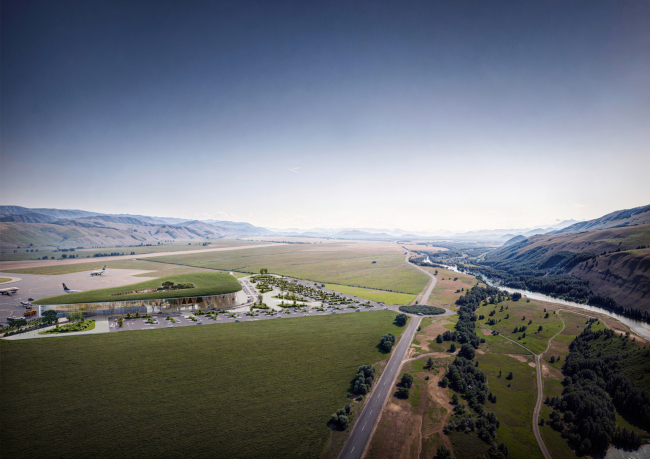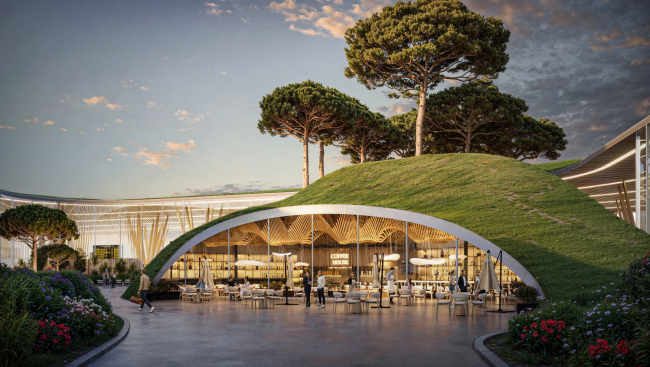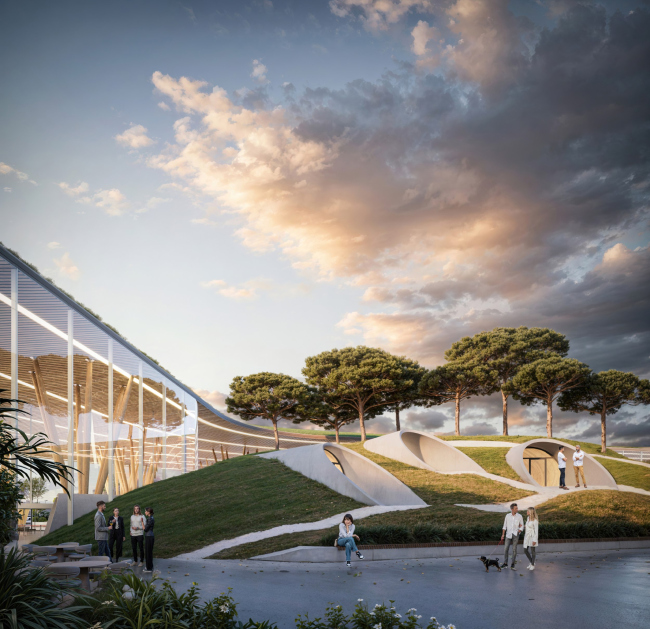|
Published on Archi.ru (https://archi.ru) |
|
| 25.09.2024 | |
|
Fir Tree Dynamics |
|
|
Alyona Kuznetsova |
|
| Studio: | |
| KPLN | |
|
The “Airports of Region” holding is planning to build an airport in Karachay-Cherkessia, aiming to make the Arkhyz and Dombay resorts more accessible to travelers. The project that won in an invitation-only competition, submitted by Sergey Nikeshkin’s KPLN, blends natural imagery inspired by the shape of a conifer seed, open-air waiting spaces, majestic large trees, and a green roof elevated on needle-like columns. The result is both nature-inspired and WOW. Gateway to the Mountains New passenger terminal of the Caucasus airport. The competition project. Main pointsCopyright: © KPLNIn 2023, the Airports of Regions company held an invitation-only competition for the airport building’s concept – this will be the company’s fourth airport built entirely from scratch. It is known that the APEX and Megabudka architecture firms also participated in the competition. The winner, however, was KPLN. The airport will be built near the settlement of Zelenchukskaya, on the banks of the Bolshoy Zelenchuk River. The journey from there to Arkhyz will take 1.5 hours, to Dombay – 2.5 hours, and to Cherkessk – 45 minutes. New passenger terminal of the Caucasus airport. The competition project. Location planCopyright: © KPLNThe Flight of Seeds In their search for inspiration, KPLN architects turned to the natural elements of the region, focusing initially on the majestic coniferous trees that shape the landscape of the foothills. Then, as is common today, they shifted to a macro scale and took a closer look at the needles and seeds – particularly the seeds, where the sleek triangular core is equipped with an elegant “sail”. This sail helps the seeds glide, allowing the trees to spread their habitat. The aerodynamic properties of seeds have been extensively studied, even giving rise to a term like “sail coefficient”. In a way, tree seeds are also a bit like airplanes, which conceptually links the function of the airport to the “spirit of the place.” And overall, it offers a fresh perspective, since the theme of flight usually leads architects toward more predictable symbols like birds, turbines, and clouds. Here, though, we have fir tree seeds. New passenger terminal of the Caucasus airport. The competition project. Form makingCopyright: © KPLNThe building’s layout mirrors the shape of its inspiration – a stretched triangle with rounded corners. However, the architects moved the core to the center, transforming it into an atrium. The long side of the triangle faces the airfield, while the opposite corner points like an arrow toward the highway and river. This arrow-like direction is echoed in the surrounding landscape, including the arrangement of parks and parking lots, and then dissipates into a roundabout. In the visualizations, the circle resembles a lens through which the terminal is projected, almost like a smaller reflection of the nearby hills. New passenger terminal of the Caucasus airportCopyright: © KPLNCanopies and Hills From distant perspectives, especially from the road, the terminal resembles a grove with clearly discernible tree trunks and a dense canopy. The canopy is represented by the fully green roof – once constructed, it will be one of the largest of its kind in Russia, where such designs are still quite rare. Among comparable examples in this “weight category”, we can recall Zaryadye Park and the Kulikovo Field Museum, while the Archaeological Museum of Wooden Architecture in Sviyazhsk is a bit more modest. New passenger terminal of the Caucasus airportCopyright: © KPLNNew passenger terminal of the Caucasus airportCopyright: © KPLNThe “grove” includes not only trees but also a hill, which the architects placed at the boundary of the spaces. Part of the hill spills outside and integrates into the composition of the entrance area, organized under the wide cantilever of the canopy. The canopy is supported by clusters of columns with wooden finishes, resembling conifer needles. Meanwhile, the thin slats under the canopy evoke the appearance of lamellar gills – the underside of mushrooms like saffron milk caps, chanterelles, or milk mushrooms. New passenger terminal of the Caucasus airport. The entrance areaCopyright: © KPLNThe second part of the hill becomes the central feature of the waiting area. Inside, there is a small café with a terrace, as well as a capsule hotel – transforming what might be a frustrating necessity, due to an early or late flight, into a unique and positive experience. The open-air rest and waiting area is another exceptional solution in airport terminal typology – even if the picturesque cedar trees seen in the visualizations do not make it into the final design. But we hope they do! It’s intriguing to imagine: a giant fir seed lands on the ground and “grows,” first into the volume of the airport, and then into the towering trees of its majestic species. New passenger terminal of the Caucasus airportCopyright: © KPLNNew passenger terminal of the Caucasus airport. Green public space in the centerCopyright: © KPLNNew passenger terminal of the Caucasus airport. Green public space in the centerCopyright: © KPLNIn the Land of Wild Grasses Outside, the departure and arrival halls are separated by the hill. Upon entering the terminal, departing passengers step into a bright and welcoming space with intuitive, linear functional zones. After the check-in counters comes the security check, followed by the waiting area with panoramic windows, café islands, retail spots, and access to the “hill” hotel. Escalators lead to the second “gallery” level, where service areas and premium lounges are located. 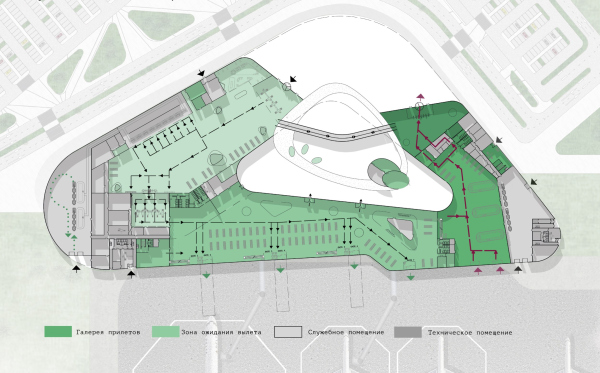 New passenger terminal of the Caucasus airport. The competition project. Fuctional zones on the 1 floorCopyright: © KPLN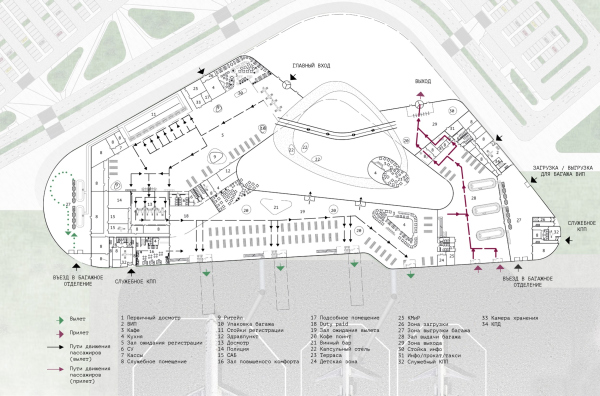 New passenger terminal of the Caucasus airport. The competition project. Plan of the 1 floorCopyright: © KPLN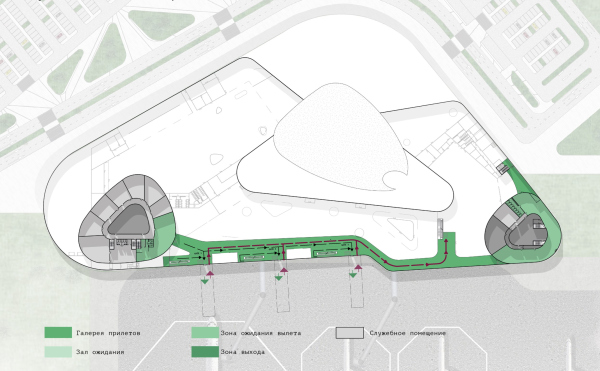 New passenger terminal of the Caucasus airport. The competition projectCopyright: © KPLN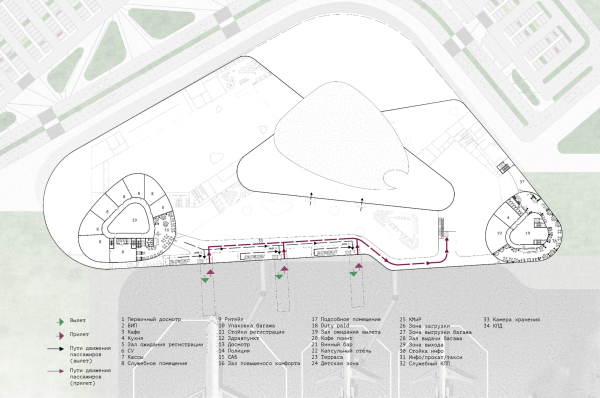 New passenger terminal of the Caucasus airport. The competition project. PlanCopyright: © KPLNThe same design techniques used outside are employed in the interior: the enormous “needles” of the columns and shrubs – which, when viewed at this scale, resemble lush moss. Clusters of columns and wooden slats are complemented by potted greenery, while LED “rivers” guide navigation. The slim window frames mimic the veil of rain or a waterfall. All of these elements – real plants and their magnified details – offer a great alternative to the often overused landscape photo wallpapers. They help emotionally extend or, conversely, begin the traveler’s immersion in the context of the Caucasus landscapes. On the other hand, if you think about it, you might catch an intriguing effect: many of us grew up reading stories where the characters shrink and see the world from the perspective of an ant or a talking pie. The most famous, of course, is Alice in Wonderland, but there are plenty of others – such as “The Extraordinary Adventures of Karik and Valya” by Yan Larri, or the later Soviet imitation “In the Land of Wild Grasses” by Vladimir Bragin. While modern architecture is certainly not guilty of literalism – you won’t find any oversized daisies like in those stories – the process of searching for imagery, as we’ve mentioned, is still highly relevant and far from exhausted. This exploration lies somewhere in the realm of a paradoxical shift in the observer’s point of view and scale, which is useful both for “defamiliarizing” the form and for sparking the imagination. Indeed, imagine these wooden slats as the gills of a mushroom (and yes, chanterelles do grow in the Caucasus mountains), with the clustered columns as the needles supporting them – and life suddenly seems just a little more interesting. New passenger terminal of the Caucasus airportCopyright: © KPLNNew passenger terminal of the Caucasus airportCopyright: © KPLNNew passenger terminal of the Caucasus airportCopyright: © KPLNThese same themes are echoed outside the building. A landscaped strip with patches of greenery, shaped like fir seeds, separates the terminal from the parking lot. The monotonous rows of cars are enlivened by green ribbons and islands of plant life.  New passenger terminal of the Caucasus airport. The landscapingCopyright: © KPLN New passenger terminal of the Caucasus airport. The competition project. The coverageCopyright: © KPLNThe airport is expected to be completed by the end of 2028, and following the progress will be fascinating. If all the planned elements are successfully implemented, the “air gateway” to Karachay-Cherkessia could become one of the region’s key landmarks, worthy of admiration and attention. New passenger terminal of the Caucasus airport. Section view 1-1Copyright: © KPLNNew passenger terminal of the Caucasus airport. Section view 2-2Copyright: © KPLN |
|



